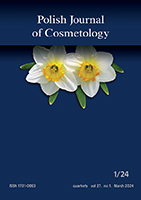search by
Copyright @ Pol J CosmetolClinical and histological changes in the course of skin photoagingAgnieszka Rucińska Pracownia Kosmetologii Uniwersytetu Medycznego w Łodzi Summary Clinical and histological changes of skin causing photoaging are induced by UVB radiation as well as long-wave ultraviolet rays - UVA. Medium-wave radiation UVB causes mainly superficial changes within epidermis, including changes in pigmentation. Although UVA radiation also stimulates melanogenesis, especially in chronic exposures, yet the main effects of UVA on skin consist in changes in dermis (chronic inflammation defined as dermatoheliosis and impairment of the connective tissue). The development of clinical and histological changes of skin is affected not only by the duration of exposure to ultraviolet but also efficient functioning of adaptational, remedial mechanisms and protective barrier in form of melanin. Therefore the changes in the image of skin and their extent vary with the skin´s phototype. Characteristic clinical symptoms of photoaging skin are: xerosis, deep wrinkles and creases, loss of the skin´s elasticity, hyperkeratosis, disordered pigmentation, teleangiectasies, solar keratosis; besides the skin´s carcinogenic changes may occur, such as melanoma, basal cell carcinoma, and spino-cellular carcinoma (especially in case of skins of phototypes I and II). Key words: photoaging, phototype of skin, solar elastosis, immunosuppression, impairments of DNA, angiogenesis |




